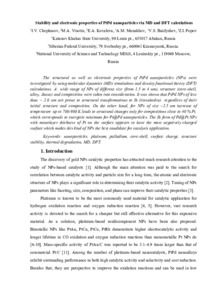Stability and Electronic Properties of PtPd Nanoparticles via MD and DFT Calculations
Скачать файл:
URI (для ссылок/цитирований):
https://pubs.acs.org/doi/10.1021/acs.jpcc.8b04177https://elib.sfu-kras.ru/handle/2311/110463
Автор:
Chepkasov, I. V.
Visotin, M. A.
Kovaleva, E. A.
Manakhov, A. M.
Baidyshev, V. S.
Popov, Z. I.
Коллективный автор:
Научно-исследовательская часть
Дата:
2018-07Журнал:
Journal of Physical Chemistry CКвартиль журнала в Scopus:
Q1Квартиль журнала в Web of Science:
Q1Библиографическое описание:
Chepkasov, I. V. Stability and Electronic Properties of PtPd Nanoparticles via MD and DFT Calculations [Текст] / I. V. Chepkasov, M. A. Visotin, E. A. Kovaleva, A. M. Manakhov, V. S. Baidyshev, Z. I. Popov // Journal of Physical Chemistry C. — 2018. — Т. 122 (№ 31). — С. 18070-18076Текст статьи не публикуется в открытом доступе в соответствии с политикой журнала.
Аннотация:
The structural as well as electronic properties of PtPd nanoparticles (NPs) were investigated by using molecular dynamics simulations and density functional theory calculations. A wide range of NPs of different sizes (from 1.5 to 4 nm), structures (core–shell, alloy, Janus), and compositions were taken into consideration. It was shown that PtPd NPs of less than ∼2.0 nm are prone to structural transformations to icosahedral (Ih) shape, regardless of their initial structure and composition. On the other hand, for NPs of size ∼2.5 nm, the increase of temperature up to 700–900 K leads to structural changes only for compositions close to 40% Pt, which corresponds to energetic minimum for Pt@Pd NPs. The Ih form of Pd@Pt NPs with monolayer thickness of Pt on the surface appears to have the most negatively charged surface which makes this kind of NPs the best candidate for catalysis application.

